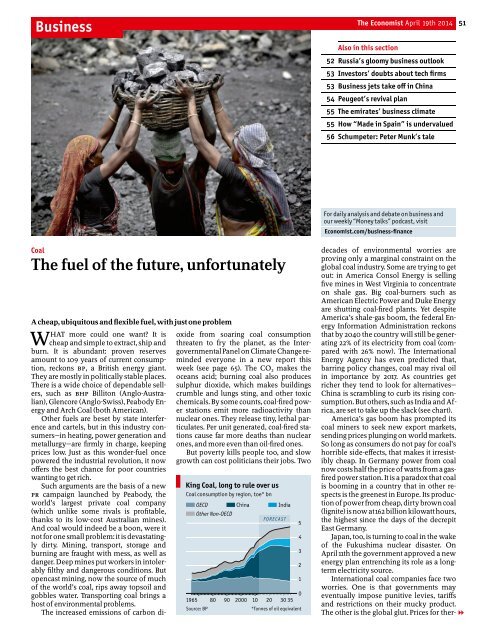The Economist - 19_25 April 2014
The Economist - 19_25 April 2014
The Economist - 19_25 April 2014
- No tags were found...
You also want an ePaper? Increase the reach of your titles
YUMPU automatically turns print PDFs into web optimized ePapers that Google loves.
Business<strong>The</strong> <strong>Economist</strong> <strong>April</strong> <strong>19</strong>th <strong>2014</strong> 51Also in this section52 Russia’s gloomy business outlook53 Investors’ doubts about tech firms53 Business jets take off in China54 Peugeot’s revival plan55 <strong>The</strong> emirates’ business climate55 How “Made in Spain” is undervalued56 Schumpeter: Peter Munk’s taleFor daily analysis and debate on business andour weekly “Money talks” podcast, visit<strong>Economist</strong>.com/business-financeCoal<strong>The</strong> fuel of the future, unfortunatelyA cheap, ubiquitous and flexible fuel, with just one problemWHAT more could one want? It is oxide from soaring coal consumptioncheap and simple to extract, ship and threaten to fry the planet, as the IntergovernmentalPanel on Climate Change re-burn. It is abundant: proven reservesamount to 109 years of current consumption,reckons BP, a British energy giant. week (see page 65). <strong>The</strong> CO 2 makes theminded everyone in a new report this<strong>The</strong>y are mostly in politically stable places. oceans acid; burning coal also produces<strong>The</strong>re is a wide choice of dependable sellers,such as BHP Billiton (Anglo-Austra-crumble and lungs sting, and other toxicsulphur dioxide, which makes buildingslian), Glencore (Anglo-Swiss), Peabody Energyand Arch Coal (both American). er stations emit more radioactivity thanchemicals. By some counts, coal-fired pow-Other fuels are beset by state interferenceand cartels, but in this industry conticulates.Per unit generated, coal-fired sta-nuclear ones. <strong>The</strong>y release tiny, lethal parsumers—inheating, power generation and tions cause far more deaths than nuclearmetallurgy—are firmly in charge, keeping ones, and more even than oil-fired ones.prices low. Just as this wonder-fuel once But poverty kills people too, and slowpowered the industrial revolution, it now growth can cost politicians their jobs. Twooffers the best chance for poor countrieswanting to get rich.Such arguments are the basis of a new King Coal, long to rule over usPR campaign launched by Peabody, the Coal consumption by region, toe* bnworld’s largest private coal companyOECDChinaIndia(which unlike some rivals is profitable,Other Non-OECDthanks to its low-cost Australian mines).FORECAST5And coal would indeed be a boon, were itnot forone small problem: it is devastatinglydirty. Mining, transport, storage and4burning are fraught with mess, as well as3danger. Deep mines put workers in intolerablyfilthy and dangerous conditions. But2opencast mining, now the source of much1of the world’s coal, rips away topsoil andgobbles water. Transporting coal brings a0<strong>19</strong>65 80 90 2000 10 20 30 35host ofenvironmental problems.Source: BP*Tonnes of oil equivalent<strong>The</strong> increased emissions of carbon didecadesof environmental worries areproving only a marginal constraint on theglobal coal industry. Some are trying to getout: in America Consol Energy is sellingfive mines in West Virginia to concentrateon shale gas. Big coal-burners such asAmerican Electric Power and Duke Energyare shutting coal-fired plants. Yet despiteAmerica’s shale-gas boom, the federal EnergyInformation Administration reckonsthat by 2040 the country will still be generating22% of its electricity from coal (comparedwith 26% now). <strong>The</strong> InternationalEnergy Agency has even predicted that,barring policy changes, coal may rival oilin importance by 2017. As countries getricher they tend to look for alternatives—China is scrambling to curb its rising consumption.But others, such as India and Africa,are set to take up the slack(see chart).America’s gas boom has prompted itscoal miners to seek new export markets,sending prices plunging on world markets.So long as consumers do not pay for coal’shorrible side-effects, that makes it irresistiblycheap. In Germany power from coalnow costs halfthe price ofwattsfrom a gasfiredpower station. It is a paradox that coalis booming in a country that in other respectsis the greenest in Europe. Its productionofpowerfrom cheap, dirtybrown coal(lignite) isnowat162 billion kilowatthours,the highest since the days of the decrepitEast Germany.Japan, too, is turning to coal in the wakeof the Fukushima nuclear disaster. On<strong>April</strong> 11th the government approved a newenergy plan entrenching its role as a longtermelectricity source.International coal companies face twoworries. One is that governments mayeventually impose punitive levies, tariffsand restrictions on their mucky product.<strong>The</strong> other is the global glut. Prices for ther-1


